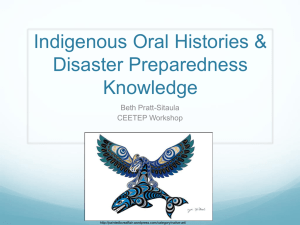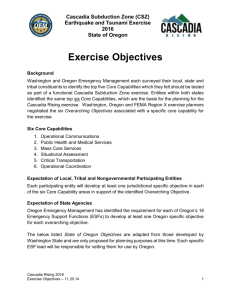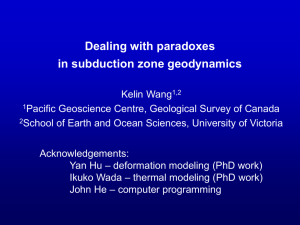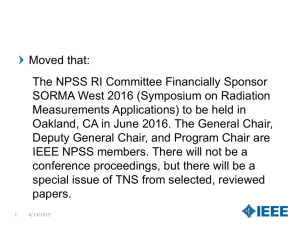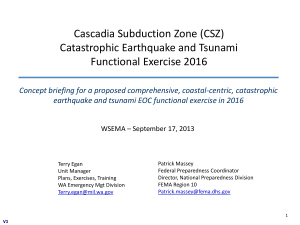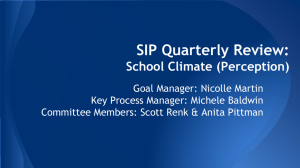CRFE-OR CO Presentation Slides-11 20 2014
advertisement
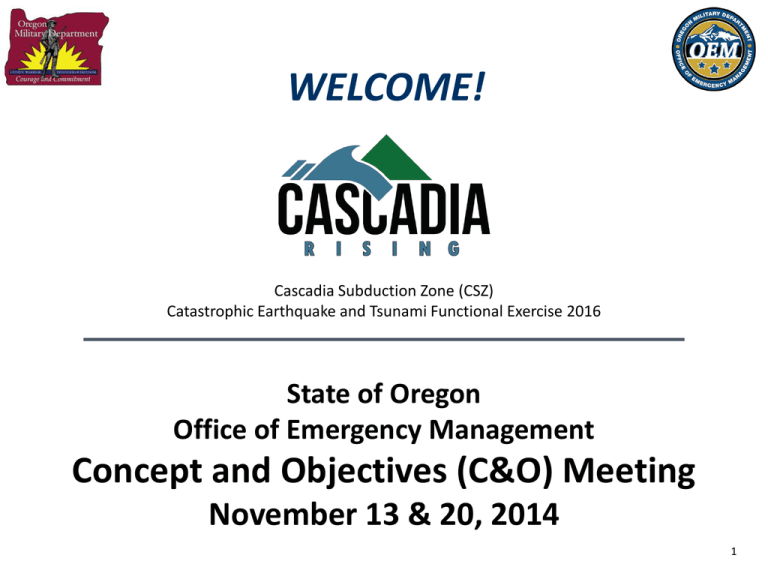
WELCOME! Cascadia Subduction Zone (CSZ) Catastrophic Earthquake and Tsunami Functional Exercise 2016 State of Oregon Office of Emergency Management Concept and Objectives (C&O) Meeting November 13 & 20, 2014 1 Cascadia Subduction Zone (CSZ) Catastrophic Earthquake and Tsunami Functional Exercise 2016 Oregon Concept and Objectives (C&O) Meeting November 13 & 20, 2014 Introduction - Welcoming Remarks 2 Cascadia Rising Exercise 2016 Introductions Name Title/Position Jurisdiction/Community/Organization Represented 3 Cascadia Rising Exercise 2016 Core Principle: Jointness Alignment Coordination Integration 4 Cascadia Rising Exercise 2016 Meeting Outcomes: • Participants understand the concept of the exercise. • Document ideas for the exercise objectives based on the six Overarching Objectives. • Solicit volunteers to serve on the Exercise Design Committee. • Socialize the Extent-of-Play Agreement. • Set the foundation for the commencement of exercise design and future ramp-up events. 5 Cascadia Subduction Zone (CSZ) Catastrophic Earthquake and Tsunami Functional Exercise 2016 State of Oregon Concept and Objectives (C&O) Meeting November 13 & 20, 2014 Final Concept of the Exercise 6 Cascadia Rising 2016 Exercise Exercise Dates: June 7 - 10, 2016 Concept: Cascadia Rising is a Functional Exercise (FE) intended to test the local, state, tribal, and federal government as well as select private sector and non-governmental organizations’ ability to jointly respond to a Cascadia Subduction Zone 9.0M earthquake and tsunami with associated aftershocks along the West Coast of the United States. Additionally, focus on emergency operations center-to-emergency operations center (EOC) operations and the ability for EOCs to coordinate all response core capability functions under the National Preparedness Goal response mission areas with an emphasis on the ‘Overarching Exercise Objectives’. 7 Cascadia Rising 2016 Exercise Scenario: 9.0 Magnitude Earthquake completely ruptures the 800-mile CSZ Fault Line. Earthquake: Ground shaking lasting up to 5 minutes. Numerous aftershocks with several of M7.0+. Corresponding Tsunami: 15 to 30 minute warning. Wave height could very from 20’ to 80’ based on location. Multiple waves hit the coast for 10-12 hours after initial shake. 8 Cascadia Rising 2016 Exercise Tiered Approach to Developing Exercise Objectives: Overarching Objectives are derived from the 14 Response Core Capabilities as listed in the National Preparedness Report. Overarching Objectives Joint Objectives Tactical Objectives 1. Operational Communications 2. Public Health and Medical Services 3. Mass Care Services 4. Situational Assessment 5. Critical Transportation 6. Operational Coordination State Objectives are the critical major operational tasks embodied within each of the broad Overarching Objectives. These tasks require collaboration amongst multiple levels of government to occur and be effective. Tactical Objectives are those typically associated with unique individual EOC processes and procedures. 9 Cascadia Rising 2016 Exercise Overarching Exercise Objectives: Operational Communications (ESF-2 & 14) Demonstrate the ability of EOCs to establish and sustain voice and data communications with other EOCs and with the general public to include basic restoration of communications infrastructure within the impacted area to support response operations and coordinated public messaging. Health and Medical Services (ESF-8) Demonstrate the ability to organize, coordinate, and deliver targeted public health and medical services to disaster survivors to include temporary medical facilities, medical surge operations, and patient collection, evacuation and transport to save lives and reduce the suffering of disaster survivors. Mass Care Services (ESF-6/11/17) Demonstrate the ability to coordinate and deliver life-sustaining services to disaster survivors with a focus on hydration, feeding, emergency sheltering, evacuations, and donations and volunteer management. 10 Cascadia Rising 2016 Exercise Overarching Exercise Objectives (continued): Situational Assessment (ESF-5) Demonstrate the ability of EOCs at all levels to provide decision-makers and EOC officials with relevant information regarding the extent of disaster damages to critical infrastructures and other facilities, cascading effects, and the status of ongoing response operations and share this information with other EOCs and critical stakeholders. Critical Transportation (ESF-1) Demonstrate the ability to establish access into impacted areas via appropriate ground, air, and maritime transportation corridors to deliver response teams, equipment, and disaster relief supplies to meet the basic needs of disaster survivors and stabilize the incident. Operational Coordination (ESF-5 & ESF-7) Demonstrate the ability to establish operational control and coordination structures within the impacted region to include the mobilization, employment, and sustainment of critical internal and external response resources to meet basic survivor needs and stabilize the incident. 11 Cascadia Rising 2016 Exercise Anticipated Exercise Participants: OR Coastal, I-5 Corridor, and Eastof-the-Cascades cities, counties, and tribes OR OEM, state agency Emergency Support Functions FEMA Region 10 and regional federal interagency partners FEMA National Response Coordination Center (NRCC) - TBD Department of Defense (NORTHCOM, NRNW, etc.) i.e. Ardent Sentry Nongovernmental Organizations (VOAD) Select private sector partners Private and public critical infrastructure lifeline providers Public FSE components (e.g. Tsunami Evacuation Drills) - TBD 12 Cascadia Rising 2016 Exercise Parameters of Play – Local and Tribal EOCs: Option 1: Locals play 4 days for 8-hours at full activation. Option 2: Locals play minimum of 2 days for 8-hours at full activation and staff EOCs with a Simulation Cell remaining 2 days. • EOCs only participating for two days must play either Days 1 and 2 or Days 2 and 3. • The purpose of the Simulation Cell (SimCell) is to simulate/mimic all facets of an EOC operation in lieu of a full complement of staff. The SimCell should be staffed at the appropriate level to support functions that include but are not limited to Resource Management, Operational Communications and Coordination, Situational Awareness, and External Affairs. 13 Cascadia Rising 2016 Exercise Parameters of Play – OR State ECC and FEMA Region 10 Regional Response Coordination Center (RRCC): Play 4 days for 8-hours at full activation. Parameters of Play – Supporting Agencies: Agencies, departments, and other components supporting EOCs agree to provide appropriate staff per EOC plans and procedures, and at the direction of the EOC Director or Manager. 14 Cascadia Rising Exercise 2016 Joint Military Exercise Activities: Concurrent with the regional Cascadia Rising activities, the Department of Defense and the National Guard bureaus of both states, will be engaged in conducting joint military response exercises using a Cascadia Subduction Zone earthquake and tsunami scenario. Four separate, but integrated exercises will be conducted involving multiple military assets and resources deployed in support of civilian authorities. Ardent Sentry Vigilant Guard Ultimate Caduceus Joint Logistics Over-the-Shore (JLOTS) 15 Cascadia Rising 2016 Exercise Exercise Design Milestones: Scenario Document Socialize Concept 2013 Extent of Play Agreements 2014 Exercise Concept and Series ‘Kick Objectives Off’ Meeting Meeting ‘Ground Truth’ Document EXPLAN 2015 Initial Planning Meeting Inject Writing MSEL Exercise Eval Guides C&E Training CSZ 2016 Functional Exercise 2016 Mid-Term MSEL Planning Synchronization Meeting Meetings 2017 Final Planning Meeting After Action Report Published 16 Cascadia Subduction Zone (CSZ) Catastrophic Earthquake and Tsunami Functional Exercise 2016 State of Oregon Concept and Objectives (C&O) Meeting November 13 & 20, 2014 Oregon Exercise Objectives 17 Oregon Exercise Objectives Development State Exercise Objective Methodology: Supporting the Overarching Exercise Objectives, Oregon has identified a selection of State Exercise Objectives to be used as a point of integration between all participating state agencies, local and tribal governments, and private sector entities. These State Objectives are keyed to six core capabilities, and associated Emergency Support Functions. Expectations of Local, Tribal and Non-Governmental Participating Entities: Each participating entity will develop at least one jurisdictional-specific objective in each of the six Core Capability areas in support of the identified Overarching Exercise Objectives. 18 Oregon Exercise Objectives Development (continued) Expectations of State Agencies: Oregon Emergency Management has identified the requirement for each of Oregon’s 18 Emergency Support Functions (ESFs) to develop at least one Oregon-specific objective for each Overarching Objective. 19 Cascadia Subduction Zone (CSZ) Catastrophic Earthquake and Tsunami Functional Exercise 2016 State of Oregon Concept and Objectives (C&O) Meeting November 13 & 20, 2014 Exercise Design Governance Structure 20 Exercise Design Governance Structure Exercise Design Organization The purpose of the Exercise Design Governance Structure is to organize the design teams into exercise design subcommittees and work group to collaboratively develop the full suite of exercise planning/design products to ensure successful exercise play that will assist in the demonstration of overarching, joint, and community-specific exercise objectives. 21 Exercise Design Governance Structure 22 Exercise Design Governance Structure Steering Committee: Responsible for overseeing all elements of exercise design and providing direction to exercise work groups and subcommittees to ensure a coherent and coordinated exercise design. • Approves work group charters. • Monitors work group and subcommittee progress towards exercise design milestones. • Ensures that all planning elements of Cascadia Rising complement and conform to the overall exercise mission statement and overarching and joint objectives. • Adjudicate conflicts or discrepancies among the work groups and subcommittees, and their various work products. 23 Exercise Design Governance Structure (continued) Exercise Design Subcommittee: Responsible for overall design of the exercise and development of the exercise documentation. • Lead all Exercise Planning Meetings (IPM, MPM, FPM, etc.). • Develop and publish Oregon Exercise Objectives. • Develop Exercise Documents (ExPlan, Control Document, etc.). • Identify MSEL tool; consolidate all exercise injects into tool; assist in development of local, state, federal, and tribal injects. • Development of Extent of Play for staffing and simulation requirements. • Work with Scenario & Ground Truth work group to establish starting trigger and ensure scenario injects are based on Ground Truth. • Single Master Control Cell (MCC) to include all simulation and control. 24 Exercise Design Governance Structure (continued) Scenario & Ground Truth Work Group: Responsible for the development of the Cascadia Rising Scenario Report and Ground Truth Document that is scientifically plausible and maximizes the opportunity for stakeholders to demonstrate exercise objectives. • Develop Work Group charter. • Assist Community/Department/Agency Lead Exercise Planners in identifying ‘simulated’ damages and casualty information necessary for the demonstration of specific exercise objectives. • Collaborate with the SMEs from the Core Capability Subcommittees. • Utilize Cascadia Rising Scenario Report to develop and publish the ‘Ground Truth’ Document. 25 Exercise Design Governance Structure (continued) External Affairs Work Group: Responsible for the coordination of real-world and synthetic media, provides direct oversight of VIPs/observers, and coordinates exercise participation of private sector organizations. • Develop Work Group charter. • Provides information on the exercise to real-world media prior to, during, and after conduct of exercise. • Provides information on the exercise to exercise planners and players. • Develops and coordinates synthetic media products for exercise play. • Ensures private sector requests for participation are processed and coordinated. 26 Exercise Design Governance Structure (continued) Exercise Objectives/MSELs Work Group: Responsible for integrating state and local exercise objectives and for the development of exercise MSELs. • Develop Work Group charter. • Receive, review, consolidate, and integrate MSEL injects from participating entities. • Ensure that MSELs relate to Ground Truth Document. • Ensure master exercise timeline is maintained during play. • Coordinate with Simulation Cells. 27 Exercise Design Governance Structure (continued) Training Work Group: Responsible for assessing training needs amongst participating organizations, and identifying and coordinating the delivery of training events to fill needed gaps, and assist in the coordination of ramp-up events. • Develop Work Group charter. • Develop and deliver Cascadia Rising Training Plan. • Identify training needs based on submitted requests and recommend training based on the overarching and joint exercise objectives. • Assist in the coordination and delivery of ramp-up events – i.e., seminars and workshops. 28 Exercise Design Governance Structure (continued) Exercise Control Subcommittee/Agency Lead Exercise Planners: Each participating community and agency is responsible for providing a Lead Exercise Planner/Trusted Agent dedicated to support exercise design for their respective community/agency in accordance with the Extent of Play. • Serve as a ‘Trusted Agent’ and attend all CSZ exercise planning meetings pertinent to the represented community/department/agency. • Contribute organization information into the overall CSZ Exercise Plan, Exercise Evaluation Guides, Ground Truth document, and other exercise design documents. • Develop organization-specific exercise objectives and injects. • Provide a sufficient number of controllers and evaluators for the EOC during exercise play. • Develop an organization-specific EOC exercise After Action Report (AAR) and provide input into the whole community AAR. 29 Exercise Design Governance Structure (continued) Evaluation Work Group: Responsible for the development of the evaluation documentation (e.g. Exercise Evaluation Guides (EEGs), After Action Report, etc.) and coordination of the exercise evaluation. • Develop Work Group charter. • Coordinate exercise evaluation planning and implementation to ensure effective and efficient synchronization of evaluation activities. • Develop and distribute format of EEGs. • Identify and plan the necessary means to evaluate the objectives during Cascadia Rising. • Develop and deliver evaluation documentation (e.g. Evaluation Plan and Evaluator Handbook) to support evaluation of the exercise. • Develop and deliver training for evaluators. 30 Cascadia Subduction Zone (CSZ) Catastrophic Earthquake and Tsunami Functional Exercise 2016 State of Oregon Concept and Objectives (C&O) Meeting November 13 & 20, 2014 Next Steps 31 Cascadia Rising 2016 Exercise Next Steps December 8: Design Committee Membership Applications and Signed Extent of Play Agreements (XPAs) due! December 15: Exercise Design Governance Structure with names solidified. Volunteers notified which Sub-working Group or Subcommittee in which they will be serving. December 29: Exercise players list (communities and agencies) finalized and distributed. January 2015: Design and Control Sub-Working Group finalizes and publishes the Joint Exercise Objectives. 32 Cascadia Rising 2016 Exercise Next Steps (continued) This Spring: Schedule for first seminar/workshop ramp-up events (January 7, 2015) Community and Agency exercise objectives due (date TBD) Publication of Exercise Scenario document (date TBD) 33 CLOSING COMMENTS & THANK YOU 34
